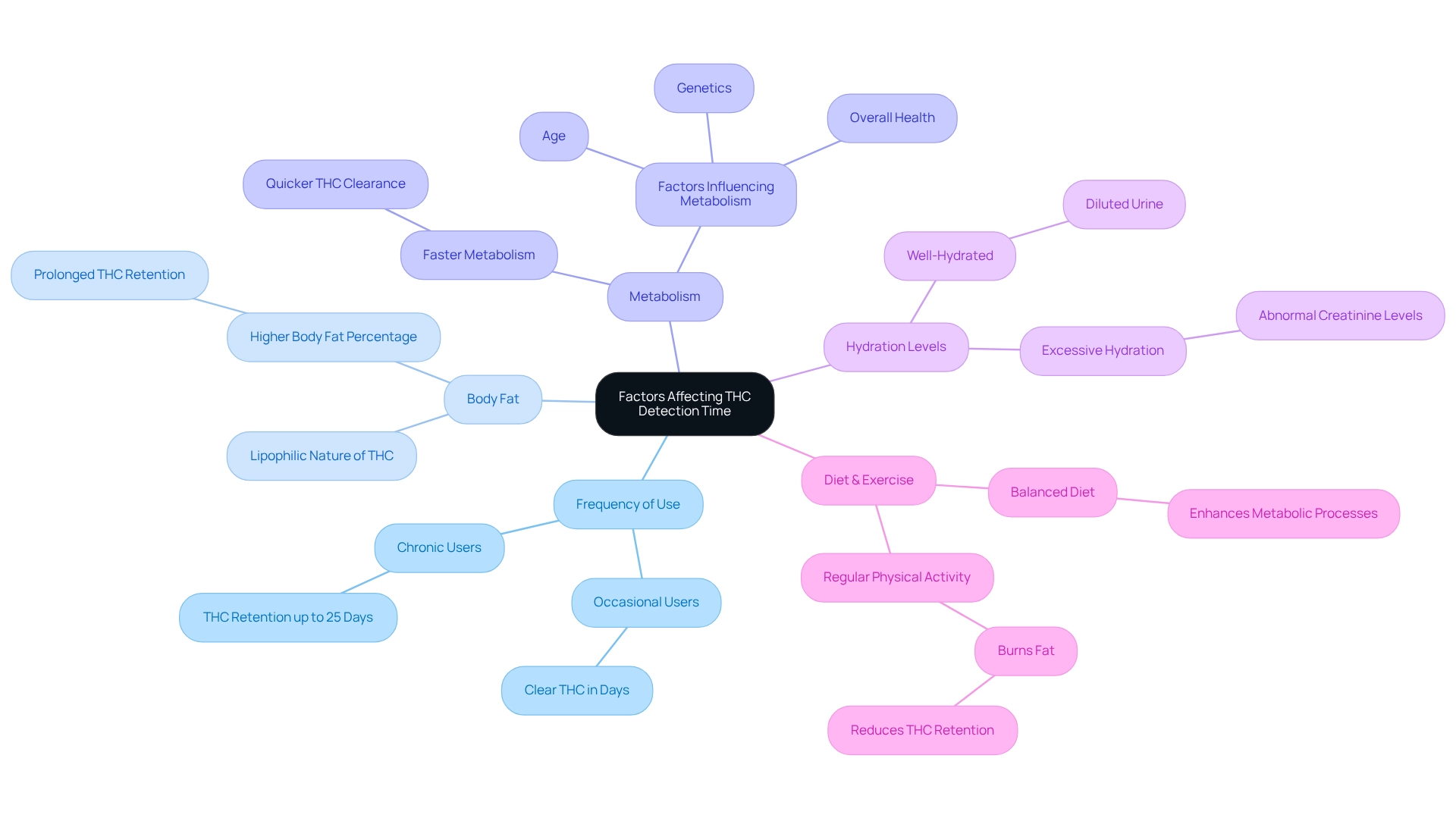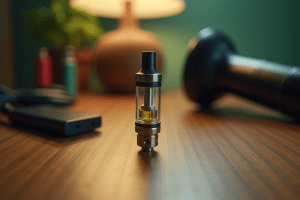Overview
Understanding how long weed remains detectable in urine can be concerning for many. The duration varies significantly:
- Occasional users might clear THC within just a few days,
- While those who use it more frequently may find it detectable for over 30 days.
This variability can feel overwhelming, but it’s influenced by several factors, including:
- How often one uses
- Body fat percentage
- Metabolism
- Hydration levels
We know that these factors can impact detection timelines, and it’s important to recognize that everyone’s body is different. By exploring these elements, we can gain a clearer picture of THC metabolism and how it affects us personally. Have you ever wondered how your lifestyle choices might affect your body’s processing of THC?
Together, we can navigate this complex topic. Understanding these nuances not only empowers you to make informed choices but also helps you feel more in control of your health. So, take a moment to reflect on your experiences and consider how they align with what we’ve discussed. Your journey towards understanding THC and its effects is important, and we’re here to support you every step of the way.
Introduction
As cannabis consumption becomes more mainstream, it’s essential to understand the intricacies of THC metabolism and detection, especially if you’re navigating potential drug testing scenarios. THC, the primary psychoactive compound in cannabis, embarks on a complex journey through our bodies. It is primarily metabolized in the liver into various metabolites, with THC-COOH being the most significant for urine tests.
Detection windows can vary widely based on factors like usage frequency, body composition, and testing methods. This variability can feel overwhelming, but arming yourself with knowledge is empowering. Together, we can explore the nuances of THC metabolism, the factors that influence detection times, and effective strategies for expediting clearance from the body.
By understanding these elements, you can make informed decisions that align with your needs. Additionally, we’ll shed light on the evolving landscape of cannabis legislation and its implications for users today. Let’s navigate this journey together, ensuring you feel supported and informed every step of the way.
Understand THC Metabolism and Detection
THC (tetrahydrocannabinol) is the primary psychoactive compound in cannabis, and its journey through the body can feel complex and concerning. Upon consumption, THC is absorbed into the bloodstream and primarily metabolized in the liver. Here, it transforms into several metabolites, with 11-OH-THC and THC-COOH being the most significant. THC-COOH is particularly important as it is the main metabolite found in urine analyses, often lingering in the body long after the psychoactive effects have faded.
Have you ever wondered how long does it take for weed to be cleared from urine? Recent studies suggest that chronic heavy users may show positive results for THC metabolites more than 30 days after their last use. This highlights the extended observation period linked to frequent consumption. For instance, Mayo Clinic Laboratories has developed a marijuana monitoring evaluation that accurately identifies both delta-9 THC and delta-8 THC metabolites through urine testing. This advancement addresses the challenges of accurately characterizing marijuana use, offering a reliable method for distinguishing between different THC isomers. This is crucial for both clinical and legal contexts, especially for consumers who may be anxious about how their usage could be interpreted in various settings.
It’s important to understand how long does it take for weed to be cleared from urine, since various drug evaluations for cannabis have different identification periods. Carly Vandergriendt notes, “Various drug tests for cannabis have different identification periods,” highlighting the significance of comprehending how THC is metabolized. The liver plays a pivotal role in this process, as it not only breaks down THC but also influences how long it remains detectable in the body. As cannabis legalization continues to grow, understanding these metabolic processes becomes increasingly crucial for consumers, particularly those concerned about drug evaluations and the effects of THC presence in their bodies. Additionally, with the evolving landscape of cannabis laws, it’s essential for consumers to be aware of what employers need to understand regarding marijuana testing in 2023. This knowledge can help ensure they are prepared for any potential consequences of THC identification in the workplace.
Furthermore, did you know that the decision ratio for THC identification can be determined by dividing the second creatinine-normalized THC-COOH result by the first creatinine-normalized carboxy-THC? This offers additional insight into the metrics of THC identification that consumers should be aware of. Together, we can navigate these complexities and make informed choices about cannabis use.
Identify Factors Affecting Detection Time
Several factors significantly influence how long THC remains detectable in urine:
- Frequency of Use: If you use cannabis occasionally, you might clear THC from your system within a few days. However, chronic users may be concerned about how long does it take for weed to be cleared from urine, as they can retain THC for up to 25 days. This extended detection window highlights the importance of understanding your personal usage patterns. Remember, just because marijuana is detected in your system, it doesn’t mean you are impaired.
- Body Fat: THC is lipophilic, meaning it binds to fat cells. If you have a higher body fat percentage, you may experience prolonged THC retention, as the compound can be stored in fat tissue and released slowly over time.
- Metabolism: A faster metabolism can help clear THC from your body more quickly. Factors like age, genetics, and overall health play a role in metabolic rates, which can impact how swiftly THC is eliminated.
- Hydration Levels: Staying well-hydrated can dilute your urine, potentially affecting test results. However, excessive hydration might raise suspicions during evaluation, leading to abnormal creatinine levels.
- Diet and Exercise: Maintaining a balanced diet and engaging in regular physical activity can enhance your metabolic processes, aiding in the clearance of THC. Exercise may also help burn fat, potentially reducing THC retention.
Additionally, some individuals may seek to manage their THC levels through various cleansing methods, as discussed in the case study titled “Cleansing Methods and Drug Testing.” While some believe these methods are effective, they may lead to unusual creatinine levels in urine, raising concerns during evaluation.
Understanding these factors can empower you to assess how long does it take for weed to be cleared from urine during your observation periods more accurately, helping you make informed choices about cannabis use and evaluation. Together, we can navigate these complexities with care and awareness.
Explore Testing Methods and Their Timeframes
Understanding the various methods for testing THC levels in the body can be crucial for anyone facing potential drug evaluations. Each method has its unique detection windows, and being informed can help you navigate these situations with confidence.
Urine tests, which are the most common testing method, can help determine how long does it take for weed to be cleared from urine, as they can detect THC for 1 to 30 days after consumption. The timeframe for how long does it take for weed to be cleared from urine largely depends on how frequently and how much one uses cannabis. Occasional users may wonder how long does it take for weed to be cleared from urine, which is often around 10 days or less. According to a case study on laboratory drug assessments, these evaluations are designed to be highly accurate and follow strict protocols, making them a trustworthy option for drug screening.
- Blood Assessments: Typically, blood tests can detect THC for 1 to 7 days, with shorter identification periods for those who use cannabis infrequently. Many prefer blood analyses for their ability to show recent usage, which can be important in certain contexts.
- Saliva Examinations: If you need to identify recent consumption, saliva tests can detect THC for up to 24 hours after use, offering a quick and effective assessment.
- Hair Tests: Though less common due to higher costs and longer processing times, hair tests can detect THC for up to 90 days. This method provides a longer-term view of substance use, but it’s not typically used for routine assessments.
Recognizing these assessment methods and their respective timeframes is essential for preparing for possible drug evaluation situations. Dr. Smith, a lab technician, emphasizes, “Immunoassay analyses are excellent for initial screenings due to their speed and efficiency.” Choosing the right testing approach can significantly impact the results, particularly in understanding how long does it take for weed to be cleared from urine, with urine analyses being the most frequently employed due to their reliability and established procedures.
It’s also important to understand that different drug tests for cannabis have varying detection windows, which tend to be longer with higher doses and more frequent use. Additionally, the entourage effect, which refers to how different cannabis compounds interact, may influence how THC is processed in the body. Together, let’s stay informed and prepared, ensuring that we make the best choices for our health and well-being.
Implement Strategies for Faster THC Clearance
To expedite the clearance of THC from your system, we can implement some caring strategies together:
- Stay Hydrated: Drinking ample water not only dilutes urine but also promotes the excretion of THC metabolites. Hydration plays a crucial role in detoxification, helping to flush out toxins more effectively. Have you considered how much water you’re drinking daily?
- Exercise Regularly: Engaging in physical activity boosts metabolism and promotes fat burning, which can aid in releasing stored THC. Regular exercise supports overall health and enhances the body’s natural detoxification processes. What activities do you enjoy that could get you moving more?
- Eat a Healthy Diet: A nutrient-dense diet is essential for supporting metabolic health. Foods rich in fiber, such as fruits, vegetables, and whole grains, can facilitate the elimination of toxins from the body. How can you incorporate more of these foods into your meals?
- Avoid Further THC Consumption: Ceasing all cannabis use is essential for clearing THC from your system. Continued consumption will only prolong the detoxification process. This can be a challenging step, but it’s important for your health.
- Consider Detox Products: While some products claim to assist in detoxifying the body, it’s vital to research their efficacy and safety. For instance, Toxin Rid Kits utilize a scientifically formulated three-part system designed to support the body’s natural detoxification processes, with user testimonials highlighting their effectiveness. Additionally, Old Style Aloe Shampoo is noted for its ability to cleanse hair while maintaining quality. Have you looked into which products might be right for you?
Implementing these strategies can help us manage THC levels more effectively, particularly in understanding how long does it take for weed to be cleared from urine, especially considering the increasing sensitivity of drug testing. Remember, THC can be detected in blood or saliva 2–24 hours after use, which raises the question of how long does it take for weed to be cleared from urine, making it crucial to stay informed and proactive about our health choices. Furthermore, for those considering detox products, U.S. orders over $145 qualify for free shipping, providing an incentive to explore these options. Staying informed and proactive about your health choices is key to navigating the complexities of cannabis consumption together.
Conclusion
Understanding the complexities of THC metabolism and detection is crucial for anyone navigating the cannabis landscape, especially with potential drug testing scenarios in mind. THC’s journey through the body involves various metabolic processes, primarily occurring in the liver, resulting in metabolites like THC-COOH, which are essential for urine testing. Have you ever wondered how long THC might linger in your system? The detection windows for THC can vary significantly based on factors such as usage frequency, body composition, and the testing method employed. Chronic users may find THC lingering in their systems far longer than occasional users, highlighting the importance of personal awareness regarding consumption patterns.
Multiple factors affect how long THC remains detectable, including metabolism, hydration levels, and body fat. By understanding these elements, we can empower ourselves to make informed decisions about cannabis use and its implications for drug testing. This knowledge allows users to estimate their detection windows more accurately, enabling better management of their cannabis consumption.
Moreover, various testing methods—urine, blood, saliva, and hair—each have distinct detection timeframes that can influence outcomes. Recognizing these differences is vital for anyone preparing for drug testing. What strategies can you implement to expedite THC clearance? Staying hydrated, exercising, and maintaining a healthy diet can further empower individuals to navigate their cannabis use effectively.
In an ever-evolving cannabis landscape, staying informed about THC metabolism, testing methods, and personal health choices is essential. This knowledge not only helps us make educated decisions but also ensures that we can confidently manage our cannabis consumption in a world where cannabis legislation and workplace policies continue to shift. Together, let’s navigate this journey with awareness and support.
Frequently Asked Questions
What is THC and how is it processed in the body?
THC (tetrahydrocannabinol) is the primary psychoactive compound in cannabis. Upon consumption, it is absorbed into the bloodstream and metabolized primarily in the liver, where it transforms into several metabolites, notably 11-OH-THC and THC-COOH.
How long can THC metabolites be detected in urine?
Recent studies indicate that chronic heavy users may test positive for THC metabolites more than 30 days after their last use, highlighting the prolonged detection period associated with frequent consumption.
What advancements have been made in marijuana monitoring evaluations?
Mayo Clinic Laboratories has developed a marijuana monitoring evaluation that accurately identifies both delta-9 THC and delta-8 THC metabolites through urine testing, which helps in distinguishing between different THC isomers.
Why is it important to understand THC metabolism and detection periods?
Understanding THC metabolism and the varying identification periods for cannabis drug tests is crucial for consumers, especially those concerned about drug evaluations and the implications of THC presence in their bodies.
How does the liver influence THC detection in the body?
The liver plays a critical role in breaking down THC and affects how long it remains detectable in the body, which is significant for understanding drug testing outcomes.
What should consumers know about marijuana testing in 2023?
As cannabis legalization expands, consumers should be aware of the implications of marijuana testing in the workplace and understand what employers need regarding THC identification.
How is the decision ratio for THC identification calculated?
The decision ratio for THC identification can be determined by dividing the second creatinine-normalized THC-COOH result by the first creatinine-normalized carboxy-THC, providing further insight into THC detection metrics.
Get Your Medical Card
Connect with a licensed physician online in minutes














